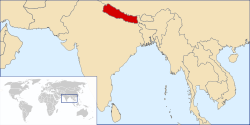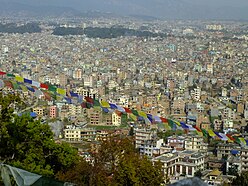
Back Nepal şəhərlərinin siyahısı Azerbaijani Lis kota ring Nepal BAN Städt in Nepal BAR नेपाल के नगरपालिका सभ के लिस्ट Bihari Daptar kuta di Nepal BJN নেপালের শহরের তালিকা Bengali/Bangla Byer i Nepal Danish Liste der Städte in Nepal German Κατάλογος πόλεων του Νεπάλ Greek Listo de urboj de Nepalo Esperanto
| This article is part of a series on |
| Administrative divisions of Nepal |
|---|
 |
| Federal Democratic Republic of Nepal (since 2015) |
|
Nepal Portal Administrative divisions by country |
| Municipality | |
|---|---|
 Kathmandu, the largest city (Metro city) | |
| Category | Municipality |
| Location | Nepal |
| Created |
|
| Number | 6 Metro City 11 Sub-metro city 276 Urban Municipality (as of 20 September 2015) |
| Populations | 845,767 - 8,370 |
| Areas | 547.43 square kilometres (211.36 sq mi) - 6.89 square kilometres (2.66 sq mi) |
| Government | |
| Subdivisions |
|
| List of Gaupalikas of Nepal |
|---|
| (alternative subdivision) |
Cities and towns in Nepal are incorporated under municipality. A municipality in Nepal is a sub-unit of a district. The Government of Nepal has set-out a minimum criteria for municipalities. These criteria include a certain population, infrastructure and revenues. Presently, there are 293 municipalities in Nepal among which 6 are metropolis, 11 are sub-metropolis and 276 are municipal councils. Other than that there are 460 rural municipalities totaling 753 local level government within Nepal.[1]
Kathmandu, the capital, is also the largest city.[2][3] In terms of area, Pokhara is the largest metropolitan city covering a subtotal of 464.28 km2[4] while Lalitpur is the smallest, with an area of 36.12 km2. Ghorahi is the largest sub-metropolitan city with an area of 522.21 km2 where as Dhangadhi is the largest sub-metropolitan city by a population of 204,788. Budhanilkantha with a population of 179,688 is the largest municipality followed by Birendranagar with a population of 154,886. In terms of area, Sitganga is the largest municipality with an area of 610.43 square kilometres (235.69 sq mi).[5]
- ^ "Total number of local bodies and ward". Open Data Nepal. 4 March 2018. Archived from the original on 5 February 2020. Retrieved 11 November 2020.
- ^ "Population of Cities in Nepal (2020)". worldpopulationreview.com. Archived from the original on 28 July 2019. Retrieved 28 July 2019.
- ^ Nepal, Naturally. "Kathmandu". Naturally Nepal. Archived from the original on 28 July 2019. Retrieved 28 July 2019.
- ^ "Pokhara Lekhnath becomes largest metropolitan city". Archived from the original on 13 March 2017. Retrieved 16 June 2017.
- ^ "Sitganga Municipality in Nepal". Archived from the original on 15 July 2018. Retrieved 19 March 2018.